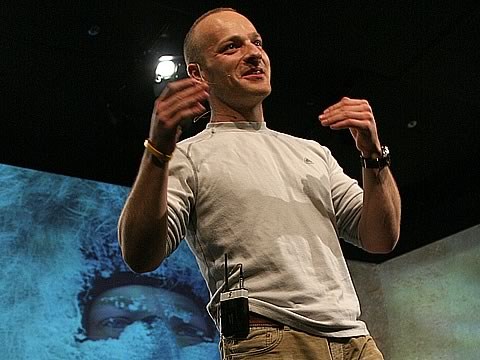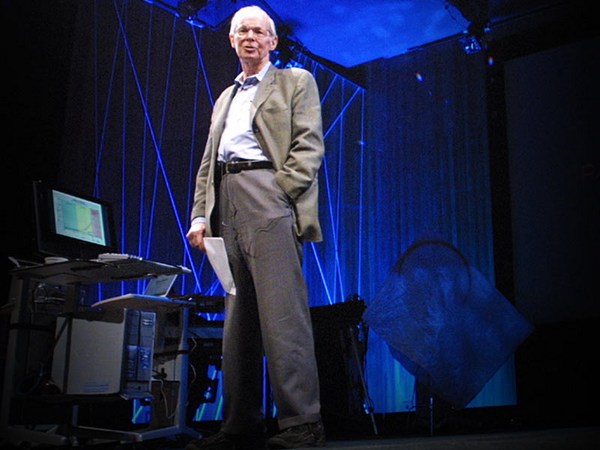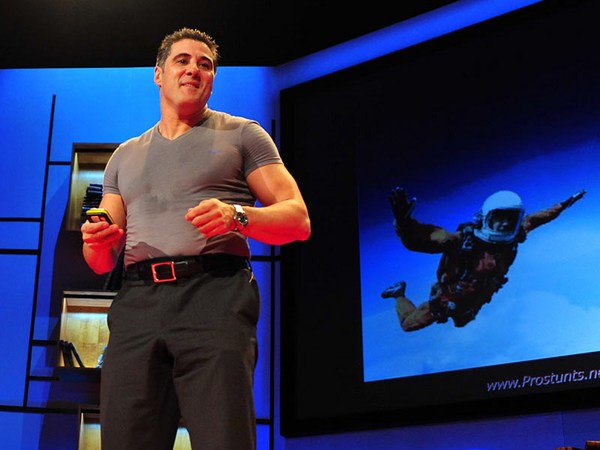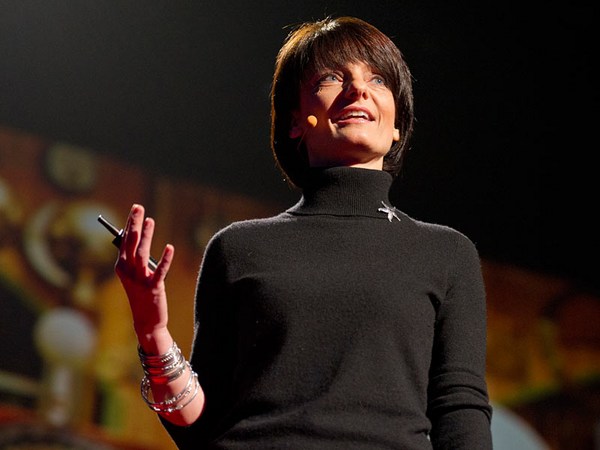I started with paragliding. Paragliding is taking off from mountains with a paraglider, with the possibility to fly cross-country, distance, just with the use of thermals to soar. Also different aerobatic maneuvers are possible with a paraglider.
From there I started with skydiving. In this picture you can see there is a four-way skydive, four people flying together, and on the left hand side it's the camera flier with the camera mounted to his helmet so he can film the whole jump, for the film itself and also for the judging.
From regular, relative skydiving I went on to freeflying. Freeflying is more the three-dimensional skydiving. You can see the skydiver with the red suit, he's in a stand-up position. The one with the yellow-green suit, he's flying head-down. And that's me in the background, carving around the whole formation in freefall also, with the helmet cam to film this jump.
From freeflying I went on to skysurfing. Skysurfing is skydiving with a board on the feet. You can imagine with this big surface of a skysurfing board, there is a lot of force, a lot of power. Of course I can use this power for example for nice spinning -- we call it "helicopter moves."
From there I went on to wingsuit flying. Wingsuit flying is a suit, that I can make fly, just only with my body. If I put some tension on my body, tension on my suit, I can make it fly. And as you see the fall rate is much much slower because of the bigger surface. With a proper body position I'm able to really move forward to gain quite some distance. This is a jump I did in Rio de Janeiro. You can see the Copacabana on the left-hand side.
From there with all the skills and knowledge from paragliding and all the different disciplines in skydiving, I went on to BASE jumping. BASE jumping is skydiving from fixed objects, like buildings, antennae, bridges and earth -- meaning mountains, cliffs. It's for sure -- for me -- it's the ultimate feeling of being in free fall, with all the visual references.
So my goal soon was to discover new places that nobody had jumped before. So in summer 2000 I was the first to BASE jump the Eiger North Face in Switzerland. Two years after this, I was the first to BASE jump from Matterhorn, a very famous mountain that probably everybody knows in here. 2005 I did a BASE jump from the Eiger, from the Monk and from the Jungfrau, three very famous mountains in Switzerland. The special thing on these three jumps were, I hiked them all and climbed them all in only one day. In 2008 I jumped the Eiffel Tower in Paris. (Laughter)
So with all this knowledge, I also wanted to get into stunts. So with some friends we started to do different tricks, like for example this jump here, I jumped from a paraglider. Or here -- everybody was freezing, pretty much, except me, because it was very cold in Austria where we did this filming. Everybody sitting in a basket, and I was on top of the balloon, ready to slide down with my skysurf board. Or this jump, from a moving truck on the highway. (Laughter)
Extreme sports on top level like this is only possible if you practice step by step, if you really work hard on your skills and on your knowledge. Of course you need to be in physical, very good, condition, so I'm training a lot. You need to have the best possible equipment. And probably the most important is you have to work on your mental skills, mental preparation. And all this to come as close as possible to the human dream of being able to fly.
So for 2009, I'm training hard for my two new projects. The first one, I want to set a world record in flying from a cliff with my wingsuit. And I want to set a new record, with the longest distance ever flown. For my second project, I have a sensational idea of a jump that never has been done before.
So now, on the following movie you will see that I'm much better in flying a wingsuit than speaking in English. Enjoy, and thank you very much. (Applause)
(Applause)
June Cohen: I have some questions. I think we all might have some questions. Question one: so does that actually feel the way the flying dream does? Because it looks like it might.
Ueli Gegenschatz: Pretty much. I believe this is probably the closest possibility to come to the dream of being able to fly.
JC: I know the answer to this, but how do you land?
UE: Parachute. We have to open a parachute just seconds before, I would say, impact. (Laughter) It's not possible to land a wingsuit yet.
JC: Yet. But people are trying. Are you among those -- you're not going to commit -- are you among those trying to do it?
UE: It's a dream. It's a dream. Yeah. We're still working on it and we're developing the wingsuits to get better performance, to get more knowledge. And I believe soon.
JC: All right. Well we will watch this space. But I have two more questions. What is the -- there was exhaust coming out of the back of the wingsuit. Was that a propelled wingsuit that you were wearing?
UE: Nope. It's just smoke.
JC: Coming off of you?
(Laughter)
UE: Hopefully not.
(Laughter)
JC: That seems dangerous.
UE: No, smoke is for two reasons, you can see the speed, you can see the way where I was flying. That's reason number one. And reason number two: it's much easier for the camera guy to film If I'm using smoke.
JC: Ah, I see. So the wingsuit is set up to deliberately release smoke so that you can be tracked. One more question. What do you do to to cover your face? Because I just keep thinking of going that fast and having your whole face smushed backwards. Are you in a helmet? Are you in goggles?
UE: The purest and the best feeling would be with only goggles.
JC: And is that how you usually fly?
UE: Usually I'm wearing a helmet. In the mountains I'm always wearing a helmet because of landings -- usually it's difficult -- it's not like regular skydiving where you have like the big landings. So you have to be prepared.
JC: Right. Now is there anything you don't do? Do people come to you with projects and say, "We want you to do this!" and do you ever say, "No, no I'm not going to."
UE: Oh of course, of course. Some people have crazy ideas and --
(Laughter)
JC: ...a round of applause...
(Applause)
UE: Thank you very much.
(Applause)





